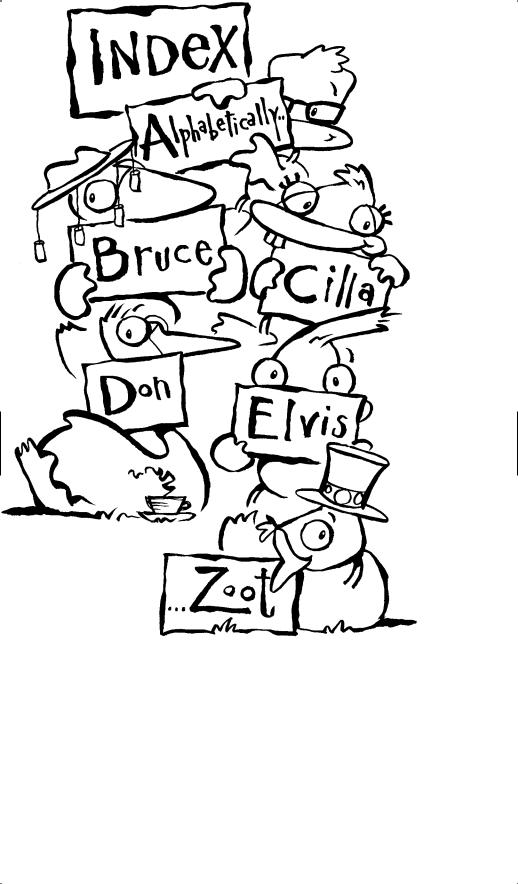

Glossary
accessor A method which can inspect the value of an attribute but not alter it. Also called a selector.
algorithm A group of operations which perform a certain task (such as sorting). May be written in a particular programming language, or pseudocode.
Application Programming Interface (API) The list of public methods and attributes describing, for the benefit of a programmer, how a particular package or language can be used. Usually provided in the form of vast amounts of documentation.
argument See parameter.
array A structure for storing a fixed number of values of the same type.
array list A structure, similar to an array that can hold a variable number of values of some type. See also vector.
assignment operator , the operator used in an assignment statement. Not the same as , which is the comparison operator.
assignment statement A statement where a value is assigned to a variable. attribute A value corresponding to a feature of an object type, which is of interest in
the real-world problem we are trying to represent. An example would be the “name” attribute of a “person” object.
backslash The “\” character, found between the left-hand shift key and the Z key on the UK keyboard.
base class A class from which derived classes inherit attributes and methods.
beta testing The testing of a program at an advanced stage of development, in order to find bugs which would only become apparent through “real” usage.
black box testing A form of testing where the actual implementation of the program is unknown.
body A collective name for the statements inside a method.
Boolean expression An expression which can be evaluated to one of true or false.
Boolean operator An operator used to make or compare Boolean expressions.
Boolean value A value which can be evaluated to either true or false.
boundary case (or boundary condition) In testing, a type of test case which tests the range of values containing a change from acceptable to unacceptable.
braces See curly brackets.
Bubblesort A simple sorting algorithm commonly used for teaching purposes. bug Unintended or undocumented behaviour in a program. Usually a bad thing,
and almost always discovered by a user.
bytecode Generated by a compiler from source code, and executed by an interpreter. Java bytecode is found in files with the .class extension.
call Both a noun and a verb. See method call.
calling method A method which calls another method. calling program A program which calls a method.
cast A way of converting a value from one type (usually a numeric type) to another.
CLAs See command line argument. class See also object type.
.class file See also bytecode.
classpath A list of locations the Java compiler and/or interpreter will search for packages imported into classes or programs.
code See also source code.
code reuse The ability to use code developed to solve one problem as part of a solution to another.
code walkthrough The process of going through a program’s source code a line or block at a time, in order to explain its operation to another person.
349

350 How to program using Java
command line argument A value provided as input to a program when it is run, via the command line.
comment A piece of code which is ignored by a compiler, but useful for providing information to programmers.
compilation The process of translating source code into an executable form. compiler A program which performs compilation.
concatenate To tag one value onto the end of another. For example, concatenating the strings “Z” and “Cars” produces another string, “Z Cars”.
condition An assertion which is either true or false. Used in conditional statements to control the flow of a program.
conditional statement A statement which evaluates a condition or set of conditions, and based on the result of this evaluation, passes control to various different parts of a program.
constant An entity whose value will never change during the life of a program. Has a type, and is referred to via an identifier.
constructor A special method which is used to instantiate an object of a given class. Must be declared public.
control statement A statement which controls the execution path of a program. control variable A variable used in a control statement which may affect the execution
path.
curly brackets (or curly braces) The symbols { and } which signify the start and end of a block of statements in Java. Not to be confused with parentheses – ( and ). data hiding The process of writing a class in such a way that the programmer need
have no knowledge of the attributes used in its implementation.
data type The sort of value which can be stored in a given attribute or variable. Examples are integers, strings, arrays, and floating-point numbers.
debugger Program used to aid debugging.
debugging The process of systematically discovering and eliminating bugs in a program. Programs to help in this process are known as debuggers.
declaration A statement which introduces a method, constant, or variable into a program or class.
decrement To reduce the value of an integer variable by one.
derived class A class which inherits attributes and/or methods from a base class. determinate loop A control loop which executes a predefined number of times.
The eventual number of iterations is known at the time of the first iteration. directory The Unix and MSDOS equivalent of a folder on an MS Windows system. driver A program written especially to test a class.
dry run Simulating the execution of a program with pencil and paper. editor A program used to create and alter source code.
element A value in an array or vector, accessible via its unique index. exception An unexpected run-time error in a Java program. executable A version of a program which can be run by a computer.
execution path The order of statements executed during the lifetime of a program. Each different execution path will cause the program to produce different results.
expression A combination of literal values, operators, and variables.
extension (or file extension) The part at the end of a filename (usually following the last dot) which is used by some programs and operating systems in an attempt to determine the file format.
flag A special command line argument, usually denoted by a / in DOS or – in Unix. floating-point number A number which includes a decimal part.
flow (of control) The sequence of statements executed in a program’s lifetime. Affected by control statements and conditional statements.
folder A set of files grouped together into one logical unit.
function A procedure for achieving some result, usually corresponding to a method. hard copy Source code printed onto paper. Useful for testing purposes and code
walkthroughs.

Glossary |
351 |
header block (or history block) Comments found at the top of a source code file, containing information about who wrote the class or program and when, plus any important changes made to the code, and usually a short description of its purpose.
high level programming Programming in a language such as Java, using a high level language that is easy for humans to understand.
identifier The name used to uniquely identify a variable within a program. increment To increase the value of an integer variable by one.
indentation Use of whitespace to make source code easier for a programmer to read. indeterminate loop A control loop which executes until a given condition is satisfied.
The eventual number of iterations through the loop cannot necessarily be determined at the time of the first iteration.
index A variable’s position within a string, array or vector.
infinite loop A loop whose exit condition can never be satisfied, and therefore executes forever. This is almost always programmer error.
initialiser list A list of values used to initialise an array.
instantiation The process of creating an object or variable of a certain type. integer A number with no decimal part.
interactive (or integrated) development environment (IDE) A piece of software which combines an editor and compiler (and usually a debugger) to aid in the rapid development of programs.
interface The specification of a class’s methods, indicating how a programmer can use that class in a program.
interpreter Reads bytecode and instructs the computer to perform some tasks. iterate To repeat a process until some condition is met. To process every element of
an array in turn, for example.
jar file (or jar archive) A sort of file containing a package or a group of packages, bundled together for convenience.
.java file Text file containing the source code for Java classes or programs.
Java Development Kit (JDK) A software bundle containing a Java compiler, interpreter, debugger, and other assorted tools, plus a whole host of predefined classes, and usually copious amounts of API and tutorial documentation. Sometimes referred to as the SDK (Software Developers’ Kit).
Java Virtual Machine (JVM) An interpreter for the Java programming language. library A group of classes provided by other programmers, offering useful function-
ality. The Java term for this is a package.
list A structure, an array list, for example, used for holding a collection of related objects.
listing See hard copy.
literal value A simple value used in an assignment. For example, any string value, or 1, or 3.142, or the character “c”.
local variable A variable created within a method, which only exists for the lifetime of that method.
loop A block of statements executed repeatedly. The number of executions is controlled by a control statement.
low level programming Programming at the machine level, perhaps using switches and levers.
method A block of code which corresponds to a particular task in the real-world problem we are trying to represent. An example would be a code to alter the name of a “person” object.
method call A statement which causes a method to be executed.
methodology A particular way of carrying out a task. In programming terms, this could be a way of analysing a problem, or a way of testing a class.
modulus The remainder operator, represented as %.
mutator A method which is used to alter the value of an attribute of an object.

352 How to program using Java
numeric type A primitive variable type representing a mathematical quantity. Examples are integers and floating-point numbers.
object An entity representing a particular instance of a class, which can be manipulated by a program.
object-oriented programming A style of programming which relies on descriptions of objects to represent a problem area.
object type Refers to a group of objects which possess the same characteristics within a problem area.
operating system (OS) The program (or collection of programs) which provides the interface between user and computer. Common examples are Linux, MS Windows, and Mac OS.
operator A symbol used to build expressions along with identifiers and literals. For example, /, *, , and are mathematical operators, while !, &&, and || are
Boolean operators.
operator precedence The order in which operators are treated within a calculation or comparison.
ordinal type A data type, the possible values of which can be listed. package The Java term for a library.
parameter A value provided to a method by its calling method. Found within parentheses in a method call.
parentheses The symbols ( and ).
portable Property of a program which can be copied across different computers and operating systems, and compiled and run with little or no alteration required.
precedence See operator precedence.
primitive type One of the basic built in types such as int, char, double, boolean, as opposed to object types.
private A kind of attribute or method which cannot be accessed directly by any code outside of the class in which it is defined.
procedural language A programming language, like Java, that specifies a procedure that will solve a problem; some other languages can be described as functional.
program A set of statements which, together, perform some task.
programmer A skilled craftsperson who develops programs. The term is not necessarily interchangeable with software engineer.
programming language A specialised language used by a programmer to express an algorithm to a computer.
prompt A message displayed by a program indicating that user input is required. prototype A name sometimes used for the heading of a method declaration. pseudocode A representation of an algorithm which is not written in any parti-
cular computer language. It usually consists of more human-oriented language rather than computer-oriented, and is written in such a way as to be clear and unambiguous.
public A kind of attribute or method which can be accessed directly by code outside of the class in which it is defined.
recursion See recursion.
reference Property of a parameter, for example, where the parameter represents not a particular value (such as “1878”), but a particular object (for example, the duck “Elvis”).
return The last stage in the execution of a method, where the flow of control reverts to the calling method. Sometimes involves a return value being provided to the calling method.
return type The data type of the value returned by a method.
return value The value passed from a returning method to its calling method. scope Of a method or attribute, whether the method or attribute is public or private. selector See accessor.
Software Development Kit (SDK) See JDK.

Glossary |
353 |
software engineer Skilled craftsperson who engages in software engineering. Not necessarily interchangeable with the term programmer.
software engineering The process of creating working software, including programming, testing, evaluation and documentation.
sorting algorithm An algorithm used to sort a collection of values into some order, determined by some rules (for example, sorting a list of names into alphabetical order).
source code A sequence of characters which are meaningful to both a programmer and a compiler.
statement A line of code which performs some task within a class.
static A method or attribute of a class which does not require an object of that class in order to be used.
string A data type representing a sequence of characters.
style The way in which a programmer lays out the source code of a program. Relies on indentation, and it is important that this is consistent.
test case (or test condition) A set of input values and their corresponding output values, used as part of a test plan to evaluate the correctness of a program.
tester A person, usually a programmer or a close associate, who applies a test plan to a program.
test harness A program used to test the implementation of a class.
test plan A set of test cases which, if all satisfied, provides sufficient evidence that a program will work as intended.
transaction Something that happens in a problem that changes some value; usually corresponding to a method.
truth table A visual representation used to show all the possible outcomes of a Boolean expression.
type See data type.
typical value A test case representing a (usually random) value which may be provided to a program by a user during the course of normal execution.
user Person who utilises a program written by a skilled programmer, and invariably discovers unexpected ways to break it. Very good at uncovering bugs.
variable A value which may change during the lifetime of a program.
variable declaration A statement where a variable is created. Includes the variable’s type and identifier, and optionally an initial value.
vector Similar to an array, but can grow and shrink during the lifetime of a program. See also array list.
void method A method which does not return a value to its calling method.
white box testing A process of testing a program, involving examining its source code. whitespace Spaces, tab characters, and newlines, used to make source code easier to
read. See indentation.

354

Entries in monospaced font are legitimate Java terms, while entries in italicised monospaced font are Java terms which, although used in this book, are not part of the standard API. Page numbers in bold type are those especially recommended for that particular topic.
// (comment delimiter) |
69, 80, 137 |
|
|||||
/* and */ (comment delimiters) |
69, 80, 88, |
||||||
137 |
|
|
|
|
|
|
|
(assignment operator) |
89, 157, 330 |
||||||
confusion with |
183, 209–211 |
|
|||||
! (Boolean “not-equal” operator) |
183, |
||||||
185, 195, 197 |
|
|
|
|
|
|
|
(Boolean equivalence operator) |
183, |
||||||
185, 187, 191, 192 |
|
|
|
|
|
||
(addition operator) |
94–95, 330 |
|
|||||
(increment operator) |
95, 330 |
|
|||||
(“add to” operator) |
|
96, 330 |
|
||||
(string concatenation operator) 94–95 |
|||||||
– (subtraction operator) |
|
94–95, 163, 330 |
|||||
–– (decrement operator) |
96, 330 |
|
|||||
– (“subtract from” operator) |
96, 330 |
||||||
* (multiplication operator) 94–95, 330 |
|||||||
* (“multiply by” operator) |
96, 330 |
||||||
/ (division operator) 94–95, 194, 330 |
|||||||
/ (“divide by” operator) |
96, 330 |
|
|||||
% (modulus operator) |
97, 108 |
|
|
||||
() (parentheses) 95, 100 |
|
|
|
|
|||
() (casting) 96, 97 |
|
|
|
|
|
|
|
(greater-than operator) |
163, 183, 186 |
||||||
(less-than operator) |
183, 186 |
|
|||||
(greater-than-or-equal-to operator) |
|||||||
183, 188 |
|
|
|
|
|
|
|
(less-than-or-equal-to operator) |
183, |
||||||
188, 195 |
|
|
|
|
|
|
|
! (“bang”, Boolean “not” operator) |
182 |
||||||
&& (Boolean “and” operator) |
182, 186, 188 |
||||||
|| (Boolean “or” operator”) |
182, 187, 194 |
||||||
.class file |
24, 25, 73, 155 |
|
|
|
|
||
.java file |
22, 69, 136, 155 |
|
|
|
|
||
accessor (method) |
141, 168, 169–171 |
||||||
adventure games |
30 |
|
|
|
|
|
|
Algol 15 |
|
|
|
|
|
|
|
algorithm |
14 |
|
|
|
|
|
|
analysis |
5, 53–62, |
|
|
|
|
|
|
Analytical Engine |
14 |
|
|
|
|
|
|
and (Boolean operator) |
182 |
|
|
|
|||
see also “&&” |
|
|
|
|
|
|
|
API (Application Programming Interface) 33 |
|||||||
documentation for Java |
243 |
|
|
||||
appending |
100 |
|
|
|
|
|
||
see also “ (string concatenation operator)” |
||||||||
argument |
68, 102, 139, 156, 336 |
|
||||||
array |
8, 115, 237, 238–242, 250, 337 |
|||||||
.length attribute |
240 |
|
|
|||||
ArrayIndexOutOfBoundsException |
||||||||
239, 251 |
|
|
|
|
|
|
||
ArrayList (class) |
237, 243–247, 273, 337 |
|||||||
accessing elements of |
246–247, 275–277, |
|||||||
278, 337 |
|
|
|
|
|
|
||
adding elements to |
244, 253, 273, |
|||||||
278, 337 |
|
|
|
|
|
|
||
creating |
243–244 |
|
|
|
|
|||
deleting elements from |
245, 254, 274–275, |
|||||||
337 |
|
|
|
|
|
|
|
|
finding size of |
244, 254 |
|
|
|||||
modifying elements of 245, 279–280 |
||||||||
array list |
see “list” |
|
|
|
|
|||
assignment (operation) |
89, 92–93 |
|||||||
see also “ ” |
|
|
|
|
|
|
||
attribute |
5, 40, 41, 43, 101, 136, 138 |
|||||||
defining |
140–141, 329 |
|
|
|||||
identifying |
57, 264–265 |
|
|
|||||
B (programming language) |
16 |
|
||||||
Babbage, Charles |
14 |
|
|
|
||||
base class |
319 |
|
|
|
|
|
||
BASIC (programming language) |
|
|||||||
15, 36, 94 |
|
|
|
|
|
|
||
BCPL (programming language) |
15 |
|||||||
beta testing see “testing, beta” |
|
|||||||
BlueJ |
33 |
|
|
|
|
|
|
|
Boolean |
|
|
|
|
|
|
|
|
condition |
201 |
|
|
|
|
|
||
expression |
182 |
|
|
|
|
|||
value 42, 181, 201 |
|
|
|
|
||||
variable |
181 |
|
|
|
|
|
||
boolean (type) |
90, 92, 181 |
|
||||||
boundary value see “test plan, boundary |
||||||||
value” |
|
|
|
|
|
|
|
|
brace (‘{‘ and ‘}’ characters) |
68, 89 |
|||||||
break (keyword) |
188, 334 |
|
||||||
BubbleSort (sorting algorithm) |
249–251 |
|||||||
BufferedReader (class) |
313, 314, 318 |
|||||||
close method |
314, 318 |
|
|
|||||
readLine method |
314, 318 |
|
||||||

356 |
|
|
|
|
|
|
|
|
|
BufferedWriter (class) |
313, 314 |
||||||||
close method |
315, 317 |
|
|
||||||
flush method |
315, 317 |
|
|
||||||
write method |
315, 317 |
|
|
||||||
bug |
14 |
|
|
|
|
|
|
|
|
bytecode |
24, 25 |
|
|
|
|
|
|||
see also “.class file” |
|
|
|
|
|||||
C (programming language) |
16, 36, 46, 89, |
||||||||
116 |
|
|
|
|
|
|
|
|
|
C (programming language) |
16, 40, 44, |
||||||||
46, 89, 116 |
|
|
|
|
|
||||
C# (programming language) |
40, 46 |
||||||||
cake, chocolate |
13 |
|
|
|
|
||||
call (method) |
154, 156–157 |
|
|
||||||
call-by-reference 223–225 |
|
|
|||||||
call-by-value 223–224 |
|
|
|
||||||
calling method |
102 |
|
|
|
|
||||
calling program |
154 |
|
|
|
|
||||
case (keyword) |
187–188, 334 |
|
|||||||
case study |
262–293 |
|
|
|
|
||||
casting |
96, 246, 266 |
|
|
|
|
||||
catch (exception handling) |
312, 317 |
||||||||
char (type) |
90, 92, 189 |
|
|
|
|||||
character |
42 |
|
|
|
|
|
|||
class |
6, 41, 70–72, 136, 153–166 |
|
|||||||
defining |
69, 263–265, 331 |
|
|
||||||
implementing |
136–151 |
|
|
||||||
testing |
300–301 |
|
|
|
|
||||
classpath |
|
34 |
|
|
|
|
|
||
COBOL (programming language) |
15 |
||||||||
code re-use |
|
40, 51 |
|
|
|
|
|||
collection |
8, 237–260 |
|
|
|
|
||||
as argument in method call |
247–248 |
||||||||
command line argument (CLA) |
113 |
||||||||
comment |
69, 80, 83, 88, 328–329 |
|
|||||||
compiler |
21, 23 |
|
|
|
|
|
|||
errors |
24 |
|
|
|
|
|
|
||
compilation |
21, 23–26 |
|
|
|
|||||
condition |
7, 179 |
|
|
|
|
||||
conditional statement |
7, 179–201 |
||||||||
Console (custom class) |
34, 118, 338–339 |
||||||||
readChar method |
214, 331 |
|
|||||||
readDouble method |
214, 331 |
||||||||
readInt method |
122, 161, 331 |
||||||||
readString method |
161, 274, 316, 331 |
||||||||
constant |
98, 108, 329 |
|
|
|
|
||||
constructor |
|
71, 101, 142–143, 155–156, 169, |
|||||||
240 |
|
|
|
|
|
|
|
|
|
control variable |
205 |
|
|
|
|
||||
Croft, Lara |
30 |
|
|
|
|
|
|||
data hiding |
|
7, 154, 168–177 |
|
|
|||||
debugger |
25 |
|
|
|
|
|
|||
debugging |
130–131 |
|
|
|
|
||||
declaration |
|
65 |
|
|
|
|
|
||
|
|
|
|
|
|
|
|
|
Index |
default (keyword) |
188, 334 |
|
|||||||
derived class |
319 |
|
|
|
|
|
|||
design, program |
5 |
|
|
|
|
|
|||
Difference Engine |
14 |
|
|
|
|
||||
digestive, chocolate |
2 |
|
|
|
|||||
dir (DOS command) |
114 |
|
|
||||||
do...while (loop construct) |
209, 217, 233, |
||||||||
258, 280, 283, 335–336 |
|
|
|||||||
double (type) |
|
66, 90, 96 |
|
|
|||||
dragon, fire-breathing |
|
30 |
|
|
|||||
driver program (testing) |
255–257, 271–272, |
||||||||
300 |
|
|
|
|
|
|
|
|
|
dry run |
303 |
|
|
|
|
|
|
|
|
element (of list) |
238 |
|
|
|
|
||||
else (conditional statement) |
163, 185–187, |
||||||||
194, 333 |
|
|
|
|
|
|
|
|
|
ending a program |
190 |
|
|
|
|||||
entity 41 |
|
|
|
|
|
|
|
|
|
exception |
311–312 |
|
|
|
|
|
|||
executable |
23 |
|
|
|
|
|
|
|
|
expression |
93 |
|
|
|
|
|
|
||
extends (keyword) |
320 |
|
|
||||||
false (Boolean value) |
181, 201 |
||||||||
file extension |
22, 114 |
|
|
|
|
||||
file I/O (input and output) |
313–319 |
||||||||
FileReader (class) |
314, 318 |
|
|||||||
FileWriter (class) |
314 |
|
|
||||||
final (keyword) |
98, 194 |
|
|
||||||
floating-point |
42 |
|
|
|
|
|
|||
flow of control |
|
211 |
|
|
|
|
|||
for loop 204–207, 212, 213, 244, 250, 277, |
|||||||||
317, 334–335 |
|
|
|
|
|
|
|||
FORTRAN (programming language) 15 |
|||||||||
function |
41 |
|
|
|
|
|
|
|
|
get method |
see “accessor” |
|
|
||||||
getting help |
34 |
|
|
|
|
|
|
||
golden rules (of programming) |
77–82, 85 |
||||||||
Gosling, James |
|
16 |
|
|
|
|
|
||
Graphical User Interface (GUI) |
322–324 |
||||||||
header block |
70, 88, 137 |
|
|
||||||
Hopper, Grace |
|
18 |
|
|
|
|
|
||
house style |
79 |
|
|
|
|
|
|
||
IDE (Integrated Development Environment) |
|||||||||
23 |
|
|
|
|
|
|
|
|
|
identifier |
89, 90, 91–92 |
|
|
|
|||||
if (conditional statement) |
163, 179, |
||||||||
184–187, 194, 332–333 |
|
|
|||||||
import (keyword) |
118, 121, 243 |
||||||||
incrementing |
94 |
|
|
|
|
|
|||
indentation |
79–82 |
|
|
|
|
|
|||
inheritance |
319–320 |
|
|
|
|
||||

Index
initialiser list (array) 241, 250 input 6, 113–123
interactive |
114, 117–119 |
|
via command-line arguments 113–117 |
||
instance |
41 |
|
int (type) |
65, 90, 92, 96, 120 |
|
integer |
42 |
|
Integer.parseInt (utility method) 120,
318 |
|
|
|
|
|
|
|
|
|
interface (of class) |
7, 140, 154 |
|
|
||||||
IOException (class) |
313, 317 |
|
|||||||
jar archive |
34 |
|
|
|
|
|
|
||
JOptionPane (class) |
323 |
|
|
||||||
JVM (Java Virtual Machine) 16, 25, 26 |
|||||||||
Kernighan, Brian |
16 |
|
|
|
|||||
library, system |
|
21 |
|
|
|
||||
LISP (programming language) |
15 |
|
|||||||
list |
8, 89, 115, 237 |
|
|
|
|||||
literal value |
93 |
|
|
|
|
|
|||
Local Guide |
22, 33, 80 |
|
|
|
|||||
login (Unix program) |
114 |
|
|
||||||
loop |
8, 203–220 |
|
|
|
|
||||
determinate |
|
206 |
|
|
|
||||
indeterminate |
|
207 |
|
|
|
||||
infinite 208 |
|
|
|
|
|
|
|||
Lovelace, Ada |
|
14 |
|
|
|
||||
main method |
88, 102, 136, 332 |
|
|||||||
method |
5, 40, 41, 44, 51, 67–69, 101, 137, |
||||||||
138–139, 222–235 |
|
|
|
||||||
as argument of another method |
225–226 |
||||||||
defining |
141–142, 336 |
|
|
||||||
designing |
59–60, 265 |
|
|
||||||
identifying |
57, 265 |
|
|
|
|||||
implementing |
|
143–144 |
|
|
|||||
main |
see “main method” |
|
|
||||||
methodology (analysis & design) |
54 |
||||||||
MIT (Massachusetts Institute of Technology) |
|||||||||
15 |
|
|
|
|
|
|
|
|
|
mutator (method) |
98, 168, 169, 171 |
||||||||
not (Boolean operator) |
183 |
|
|
||||||
see also “!” |
|
|
|
|
|
|
|
||
null value |
94 |
|
|
|
|
|
|
||
null (keyword) |
|
323 |
|
|
|
||||
NumberFormatException |
311 |
|
|||||||
object |
4, 40, 100–101, 136 |
|
|
||||||
declaring |
155–156 |
|
|
|
|||||
identifying |
54–57 |
|
|
|
|||||
object-oriented |
|
5, 40 |
|
|
|
||||
programming |
|
16, 46 |
|
|
|||||
object type |
see “type” |
|
|
|
|||||
357
operating system 13 |
|
operator precedence |
94–95 |
or (Boolean operator) |
182 |
see also “||” |
|
output 99–100 |
|
overloading methods |
320–322 |
package (keyword) |
25 |
parameter see “argument”
Pascal (programming language) 17, 38 Plankalkul (programming language) 15
portable |
15, 40 |
|
|
|
|
|
||
PrintWriter (class) |
315 |
|
||||||
private (scope) |
67, 101, 139, 154 |
|||||||
program |
12 |
|
|
|
|
|
||
designing |
60 |
|
|
|
|
|
||
programmer |
12 |
|
|
|
|
|
||
programming basics |
|
87–108 |
|
|||||
programming language |
2 |
|
||||||
programming languages |
see also Algol, B, |
|||||||
BASIC, BCPL, C, C , C#, COBOL, |
||||||||
FORTRAN, LISP, Pascal, Plankalkul, |
||||||||
Python, Simula |
|
|
|
|
||||
protected (scope) |
|
139 |
|
|||||
prototype (of method) |
222–223 |
|
||||||
pseudocode |
59, 180, 274, 278 |
|
||||||
public (scope) |
67, 68, 88, 139, 154 |
|||||||
Python (programming language) |
17, 40 |
|||||||
quotation marks (‘ and “) |
90 |
|
||||||
recursion |
see “recursion” |
|
||||||
reference (memory) |
191 |
|
|
|||||
reference parameter |
|
225, 229, 336 |
|
|||||
return (statement) |
|
89 |
|
|
||||
return type |
44, 45, 139 |
|
|
|||||
return value |
44, 45, 157 |
|
|
|||||
re-use, code see “code re-use” |
|
|||||||
Richards, Martin |
15 |
|
|
|
|
|||
Ritchie, Dennis |
16 |
|
|
|
|
|||
scope |
138 |
|
|
|
|
|
|
|
see also “public, private, protected” |
|
|||||||
selector method |
see also “accessor” |
|||||||
semi-colon |
66, 77, 92 |
|
|
|
||||
set method |
see “mutator” |
|
||||||
Simula (programming language) |
15 |
|||||||
software engineering |
|
125 |
|
|||||
sorting |
248–252 |
|
|
|
|
|
||
source code |
26, 88 |
|
|
|
|
|||
see also “.java file” |
|
|
|
|
||||
static (keyword) |
88, 222, 225, 226–227, |
|||||||
336–337 |
|
|
|
|
|
|
||
statement |
65, 66, 87 |
|
|
|
|
|||
string |
42 |
|
|
|
|
|
|
|
making comparisons |
191 |
|
||||||

358 |
|
|
|
|
|
|
|
|
String (type) |
65, 90, 92, 99, 101 |
|
||||||
equals method |
192, 201 |
|
|
|||||
equalsIgnoreCase method |
192 |
|
||||||
Stroustrup, Bjarne |
16, 46 |
|
|
|||||
style (programming) |
77–79 |
|
|
|||||
Sun Microsystems |
16 |
|
|
|
||||
switch (conditional statement) |
179, |
|
||||||
|
187–190, 258–259, 279, 283, 316, 334 |
|
||||||
systems analyst |
53 |
|
|
|
|
|||
System.err (standard error stream) |
280 |
|||||||
System.exit (static method) |
190, 201 |
|||||||
System.out.print (static method) |
1, |
|||||||
|
195, 331 |
|
|
|
|
|
|
|
System.out.println (static method) |
||||||||
|
99, 331 |
|
|
|
|
|
|
|
test case |
6, 127, 128 |
|
|
|
||||
test data |
127 |
|
|
|
|
|
||
test harness |
300 |
|
|
|
|
|||
test plan |
6, 125, 127–129, 295 |
|
|
|||||
boundary value |
129, 133 |
|
|
|||||
typical value |
129, 132 |
|
|
|||||
testing |
6, 125–134, 255–257, 271–272, 295–308 |
|||||||
beta |
131 |
|
|
|
|
|
|
|
black-box |
296–298 |
|
|
|
||||
comparison of blackand white-box |
299 |
|||||||
importance of |
125, 126, 131–132 |
|
||||||
white-box |
299 |
|
|
|
|
|||
throws (exception handling) 312 |
|
|||||||
true (Boolean value) |
181, 201 |
|
|
|||||
truth table 182 |
|
|
|
|
|
|||
try block (exception handling) |
312, 317 |
|||||||
Turing, Alan |
18 |
|
|
|
|
|||
type |
41, 42, 72, 90, 93, 136, 329 |
|
|
|||||
typical value see “test plan, typical value” |
||||||||
value parameter |
336 |
|
|
|
||||
vector (data structure) |
237 |
|
|
|||||
void (return type) |
44, 67–68, 89, 139 |
|
||||||
variable |
6, 87, 329 |
|
|
|
|
|||
declaration |
89, 90, 94 |
|
|
|||||
initialisation |
94 |
|
|
|
|
|||
Index
while (loop construct) 207–208, 215, 335
wrapper classes for primitive types 246–247
Zuse, Konrad 15
The following is a list of classes which are fully listed in the text :
ArrayDemo.java 239–240
BirdCalculator.java 105
Borrower.java 146, 172–173 BusConductor.java 320 Calculator.java 216–217 CLASign.java 117 CLATest.java 115–116 Coot.java 162–163 CootComparator.java 164 CricketingDucks.java 148–150
CricketScheduler.java 108, 126–127, 193–196
CricketScheduler2.java 121–122
Duck.java 71–72, 80, 144–145, 159–160, 173–174, 231–232, 268–271
DuckDatabase.java 285–291
DuckTracker.java 161–162
DuckTrafficControl.java
232–233
First.java 87–88 Hello.java 99
InteractiveSign.java 118–119 MangledDuck.java 81 MoneyTracker.java 106–107 Numbers.java 320–321 Person.java 319–320 PieShare.java 305–306 ReadTest.java 118
Sign.java 101–103, 323–324
Sign3.java 196–198 TimesTable1.java 120 WordStats.java 302–303
